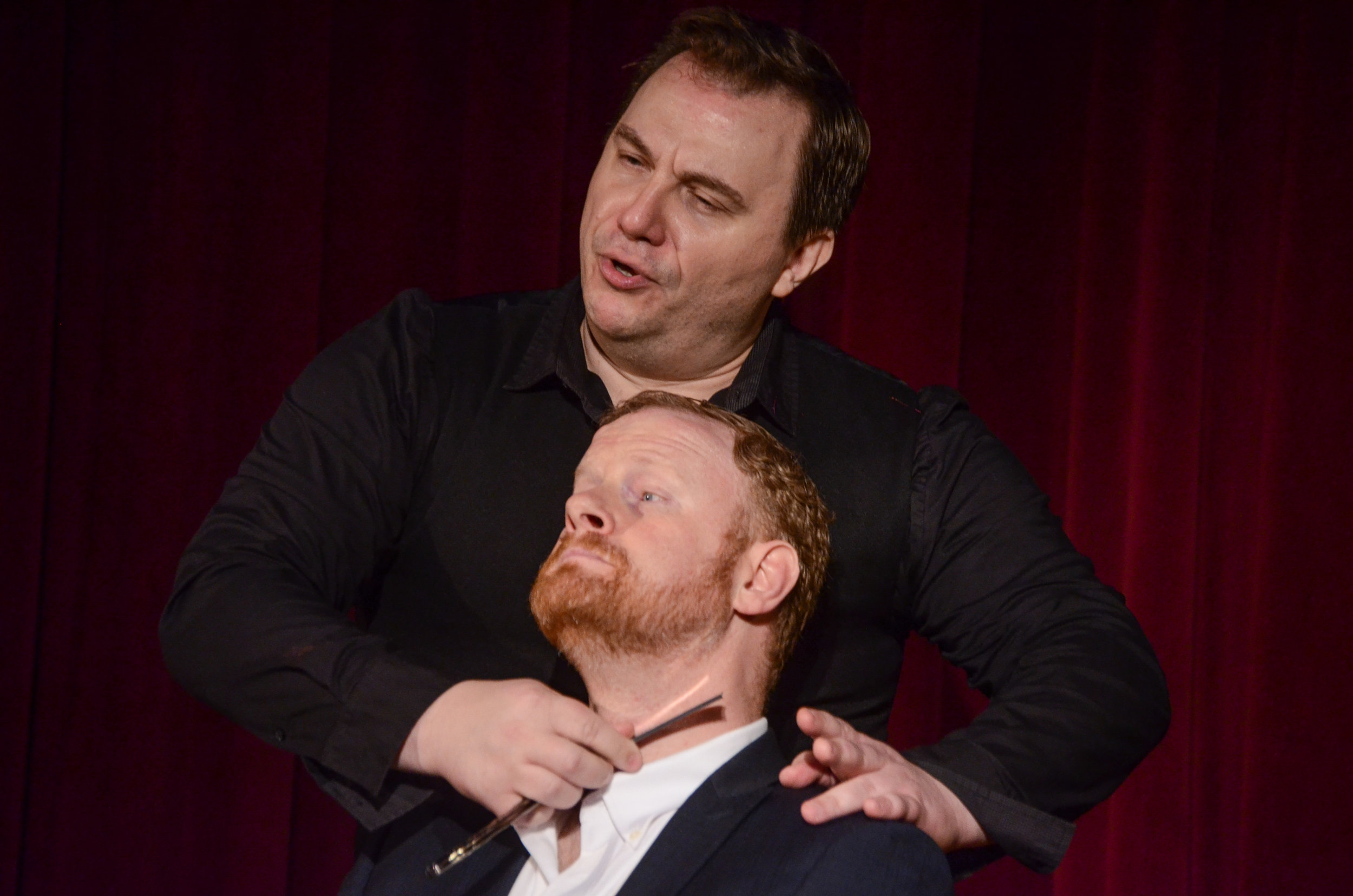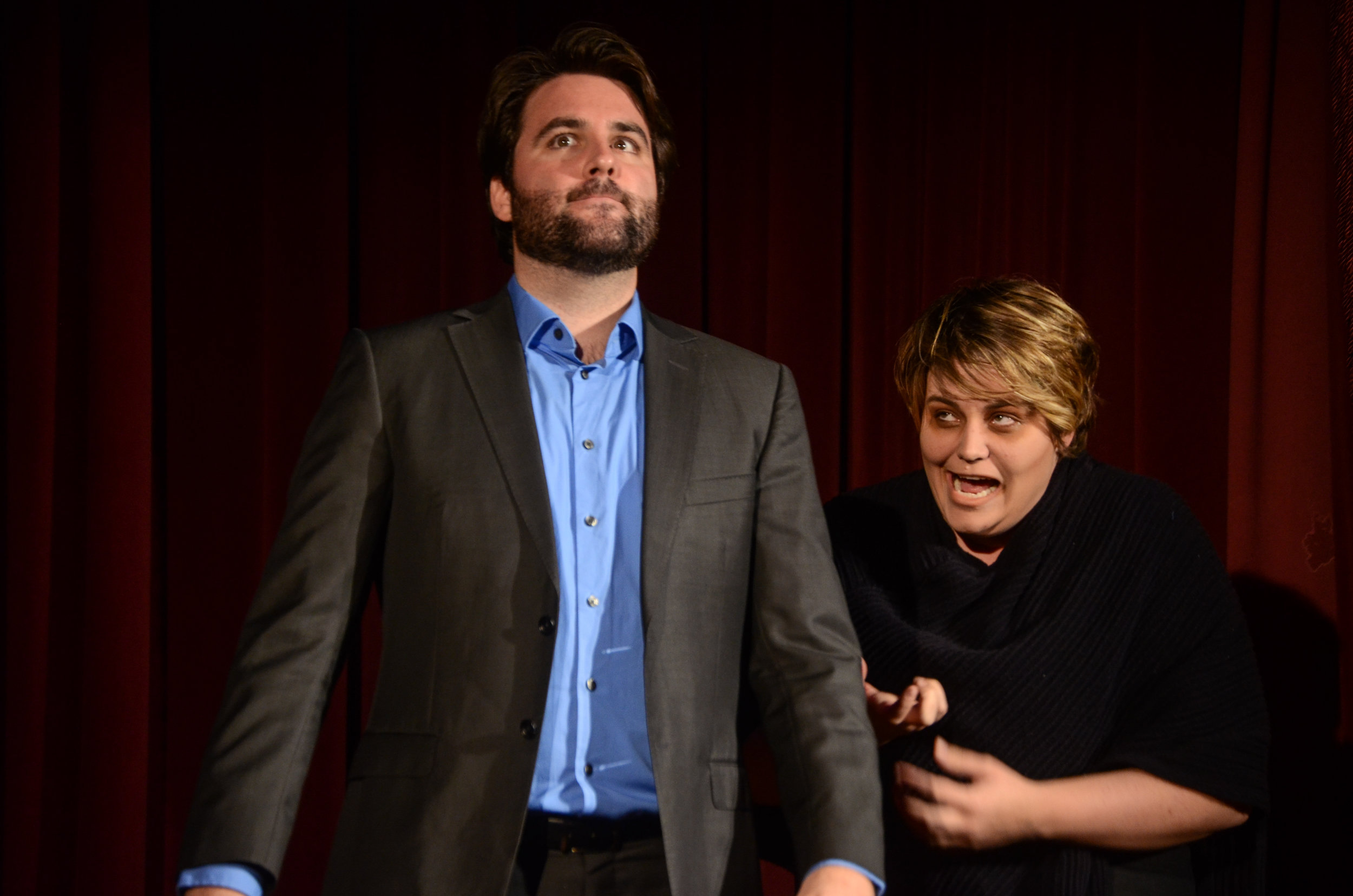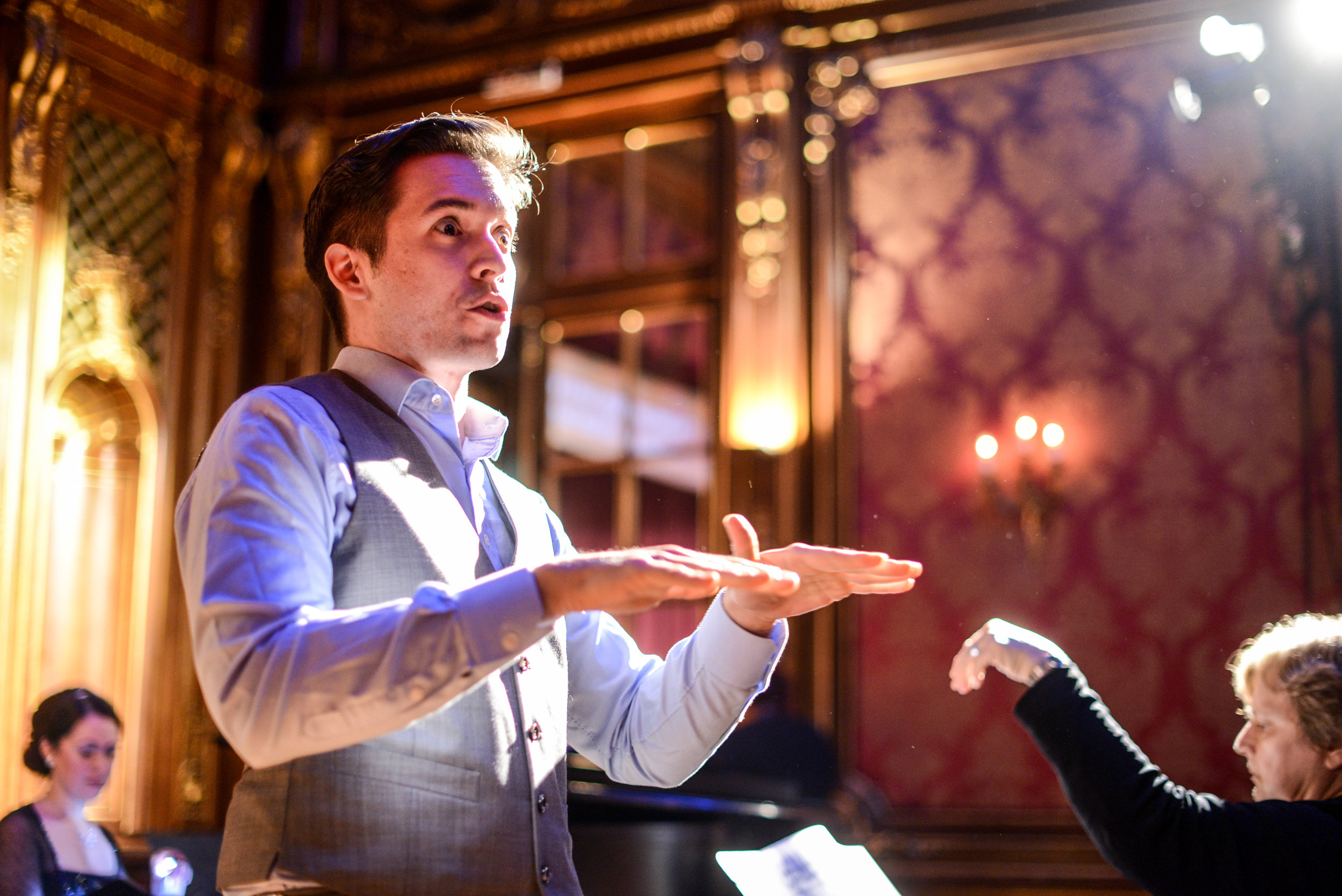It was getting uncomfortably warm in the ballroom at the Engineer’s Club in Baltimore on Sunday afternoon, where Baltimore Concert Opera was putting on Steven Sondheim’s Sweeney Todd. The unseasonably warm February weather outside was contributing, but it was the sell-out sized audience inside that was generating the heat. The climate-control recovered during the intermission, but the audience’s enthusiasm only grew as act two proceeded. When the show concluded, audience members started immediately to rise to their feet, and the applause did not end until several seconds after the last cast member had left the stage.
Ron Loyd as Sweeney Todd and Jenni Bank as Mrs. Lovett. Photo by Britt Olsen-Ecker; courtesy of Baltimore Concert Opera.
This was my first Sweeney Todd; many in the pre-talk audience raised their hands when Conductor JoAnn Kulesza asked who had seen Todd previously. I had avoided Sweeney Todd; the story seemed rather gruesome and bloody. Ms. Kulesza said Sondheim stated the story was about revenge and she noted its connection with Dies Irae. I had decided, that if ever I was going to attend, at least going to a concert opera version should be blood-free. To my surprise, I noted just before attending that it was going to be a semi-staged version. Uh…oh, the prospect of blood again. However, before it began, Director Courtney Kalbacker told me not to worry, no blood. And indeed, though we saw Mr. Todd swing his shiny razor often, the victims were dispatched bloodlessly (the first couple of times, I still closed my eyes). She explained, “We thought that the story merited some simple action onstage. A "horror" story can easily get campy if, for example, we used supertitles to explain the death scenes. We wanted to be true to the spirit of the work. Also, we knew most of our performers had experience with these roles and wouldn't be using their scores as much. We wanted to allow them to be as expressive as possible, and that included some very light staging this time.” Kudos to Ms. Kalbacker; the staging for this…what shall I call it, opera or musical…regardless, it worked. The play was acted out, with limited costumes and only a few props, but it drew me into the story more quickly and effectively. My only criticism is that the white leather chair chosen for the barber’s stool made me worry about blood stains; did they have Scotchgard in 19th century London?
Ron Loyd as Sweeney Todd and Matthew Curran as the Judge. Photo by Britt Olsen-Ecker; courtesy of Baltimore Concert Opera.
The story, if you don’t know already, centers on a barber who has served fifteen years in prison on a trumped-up charge. Assuming a new name and consumed by revenge, Sweeney Todd returns to London’s Fleet Street where he is abetted by a woman who has long had a secret desire for him, Mrs. Lovett. She tells him his wife was abused and disgraced by the Judge and she took poison; she further reveals that the Judge took Todd’s young daughter as his ward, whom he now intends to marry. Mrs. Lovett runs a rather unsuccessful bake shop and cannot afford good meat for her pies. Thoroughly embittered, Sweeney Todd believes that no one deserves to live and longs to give the Judge the closest shave he’s ever had. He starts supplying Lovett with fresh meat directly from his barber’s chair, and her business swells. In her opening remarks for the performance, Executive Director of BCO Julia Cooke noted that people ask whether Sweeney Todd is an opera or a musical. Her answer is “Yes”. I agree. It is a musical with operatic elements and is often performed by opera companies. Mr. Sondheim milks the macabre action for humor using musical elements, and it is very funny in spots, but turns very, very dark at the end; operatic singing strengthens the dark elements. Regardless, it is a show with marvelous music that is very entertaining.
left: Mackenzie Whitney as Anthony Hope and Kate Jackman as the Beggar Woman. right: Jeni Houser as Johanna. Photo by Britt Olsen-Ecker; courtesy of Baltimore Concert Opera.
The excellent ensemble cast of nine performers and a chorus complimented each other well in bringing the music and the drama to life. Sweeney Todd has spoken dialogue as well as singing and the acting was remarkably good. Pianist and Chorus Director James Harp supported the singers well with an emotional touch to his playing. For this production, the accompaniment by piano gave the performance a Broadway feel. Leading the cast was Ron Loyd as Sweeney Todd. An especially funny moment occurred when he and his admirer Mrs. Lovett, superbly played by mezzo-soprano Jenni Bank, sing about how pies made of practitioners of different professions might differ in taste ("A Little Priest"). Especially tender and moving was Tobias Ragg’s song (“Not While I’m Around”) promising to protect his mother figure Mrs. Lovett; Ragg was played by tenor Ian McEuen who shone in each of his scenes. Anthony Hope who befriended Todd and fell in love with his daughter, Johanna, is played by tenor Mackenzie Whitney. Very pretty was a duet (“Johanna”) between Hope and Todd as each sings of his feelings for Johanna, who was played effectively by soprano Jeni Houser. The supporting cast of Kate Jackman as the Beggar Woman, Matthew Curran as the Judge, Orin Strunk as Beadle, and Jeremy Blossey as Pirelli all had their moments and would be welcomed by me in any future productions that I attend.
left: Olin Strunk as the Beadle. middle: Ian McEuen as Tobias Ragg. right: Jeremy Blossey as Pirelli. Photo by Britt Olsen-Ecker; courtesy of Baltimore Concert Opera.
Sweeney Todd is worth attending just for the music and songs. As a play, it is funny and horrifying in turns. This BCO production had a good balance between those extremes. It also was a good introduction to this opera-musical for me. I like composers mixing different genres and styles when it works for a story. I have seen that done recently in Dead Man Walking, Champion, and The Summer King. One other thing - I think my assertion that The Trial of Elizabeth Cree was the first slasher opera stands, in as much as it was opera only. It might be fun though if an enterprising young composer came up with a sequel, Elizabeth Cree Meets Sweeney Todd including a marriage ceremony performed by Hannibal Lecter. Starting to feel queasy? I felt a little like that when Todd was over. I may attend another production some time; at least now I know when to close my eyes.
The Fan Experience: It is usual for Baltimore Concert Opera productions to have a strong audience turnout, but this is the first sell-out I have attended. I asked Kalbacker, who is also Managing Director to what did she attribute the sell-out. She thought the popularity of Sweeney Todd was a factor. She added, “We have been working to get the rights for Sweeney for some time and we're thrilled to be able to present it at BCO!” She also alluded to time of the year; at this point in winter, folks are staring to experience cabin fever. I might add one more. This production, like all BCO productions, are incredible values. You are not going to find Sweeney Todd of this quality anywhere else at these prices. I suspect the word is spreading about Baltimore Concert Opera.
Sweeney Todd is over for now, but BCO has two more events this year - one, a night of opera featuring Puccini’s Gianni Schicchi and Michael Ching’s comedic follow up, Buoso’s Ghost, on April 13 and 15; and one remaining Thirsty Thursday on March 22 that will feature a wine tasting. I can vouch that their Thirsty Thursdays are about as much fun as you can have attending opera.







